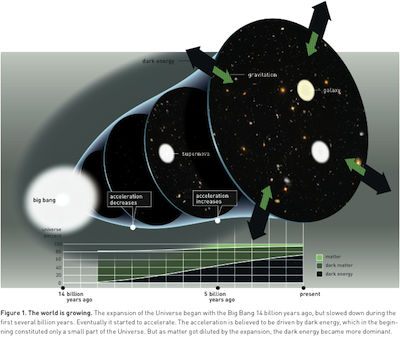Nobel Prize recognizes DARK collaborators and research aims

News of this year's Nobel Prize for Physics to Saul Perlmutter, Brian P. Schmidt and Adam G. Riess, for the discovery of the accelerating expansion of the Universe through observations of distant supernovae, is welcomed at the Dark Cosmology Centre (DARK). Dark energy which is responsible for the accelaration of the universe, is a major research theme at DARK.
Supernovae and dark energy
Supernovae (SNe) are massive explosions, associated with the violent deaths of certain stars. Some SNe can be used to measure cosmological distances. SNe have been observed throughout the history of mankind, and in 1572, Danish astronomer Tycho Brahe observed a very bright star, now recognized as a supernova, named SN 1572, which had unexpectedly appeared in the constellation Cassiopeia. In 1988 Danish astronomers, Hans Ulrik Nørgaard-Nielsen, Leif Hansen and Henning Jørgensen, used the Danish 1.5m telescope to observe the first high-redshift supernova. Their work inspired the studies now made famous by Schmidt, Perlmutter and Riess. Using SNe to measure and hence probe the early universe is an approach which has greatly enhanced our understanding of fundamental physics - dark energy and dark matter.
The importance of the study of dark energy was further recognized this week, as news came from the European Space Agency, which announced that they had selected the space mission, Euclid, for launch in 2019. Euclid's primary science mission is to further advance our understanding of dark energy. The University of Copenhagen, via the Space Science Centre and including staff at DARK, will contribute to the design and delivery of Euclid's instrumentation.
Euclid will observe several hundred million galaxies across a large part of the sky over 6 years. The observations will be used to measure the fingerprint of dark energy, dark matter, and gravity on the geometry of the universe and the evolution of galaxies. By measuring the shape of the galaxies and the distribution of galaxies in space, astronomers will measure the effect of dark energy, and whether Einstein’s general theory of relativity holds at such great distances as billions of light years.
DARK's current research staff are making strides in understanding dark energy, for example through a new method to find accurate cosmic distances using quasars which are powered by supermassive black holes. Watson, Denney, Vestergaard and Davis recently published these results. More here >>
The team of Wojtak, Hansen and Hjorth at DARK recently published in Nature a breakthrough in our understanding of dark energy, confirming Einstein's predictions, as described in his general theory of relativity. "...tested on a cosmological scale confirms that the general theory of relativity works and that there is a strong indication for the presence of dark energy”, explains Radek Wojtak. More here >>
Congratulations to our colleagues
DARK congratulates in particular, DARK Associate Scientist, Brian Schmidt of Australian National University, who has visited the centre a few times in recent years, and who is a regular collaborator of former DARK post doc, Tamara Davis, who now holds a permanent research position at the University of Queensland. Several other DARK researchers, including Davis, Féron, Fynbo, Hjorth, James, Maund, Sollerman, Stritzinger and Watson, have co-authored papers with Schmidt.
And DARK congratulates Adam Riess, who is leading a project that now includes DARK PhD student, Teddy Frederiksen and his supervisor, Professor Jens Hjorth, on finding the highest redshift supernovae to further study the acceleration and nature of dark energy. Others at DARK who have co-authored papers with Riess include Davis, Fynbo, Leloudas, Sollerman, Stritinger and Vreeswijk.
What Nobel Prize winners, Perlmutter, Schmidt and Riess discovered about our expanding universe in the late 1980s and through the 1990s laid the foundation for modern cosmology's quest to understand dark energy and dark matter. Their work inspired a new generation and new approaches, e.g., Euclid, which are now coming to fruition through observations and theoretical work done at the Dark Cosmology Centre and other leading research groups.
More on Dark Energy
DARK has contributed to the measurement of dark energy with an accuracy of better than 10%. This was achieved primarily in the context of the ESSENCE supernova collaboration.
It is now clear that w is consistent with being –1, which is the prediction if dark energy is caused by vacuum energy also known as the cosmological constant. The exploration of the nature of dark energy has increased in scale to large projects like JDEM or EUCLID.
Using the following high‐return strategy we can impact the understanding of dark energy in the absence of an industrial‐scale project: high‐accuracy models of gravitationally‐lensed sources can provide constraints on the geometry of the Universe, but require ultra‐deep observations of galaxy clusters to do so.
Such deep exposures also provide access to the most distant supernovae, a second tool to pin down the parameters that govern dark energy. The Centre continues to explore the use of supernovae to assess systematic errors in w, and will also attempt to observe supernovae at redshifts, z > 1.
It will also enter new avenues for characterizing dark energy, in particular using strong gravitational lensing to test the self‐consistency of the current concordance world model. We do not expect to find the answer to the question of dark energy but to put its existence on a firmer footing using new observational techniques by eliminating concerns over systematic uncertainties inherent in using, e.g., supernovae as standard candles, and as input to joint methods of constraining cosmological parameters.

